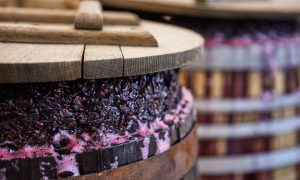As August comes to a close, many wineries have already started preparing for harvest/crush season. Harvest season in the wine industry is considered to be the busiest time of the year. It is the time where winemakers start to pick the grapes and prepare them for the crushing process before they start pressing and fermentation.
Although this may sound easy there are a few more steps to this process. As harvest season becomes closer, Hanna takes a look at the equipment winemakers use, in order to make each process a little bit easier.
Harvest season begins when growing season ends and the grapes start to change color and soften. It is also the time where the grapes lose their bright green color and start to develop a more mature color.
Winemakers can tell when it is time to harvest by:
- Color of the Grape
- Taste
- Sugar level
- Acidity
- Weather Conditions causing them to pick early
Each of these factors play an important role in the growing and harvest process.
It’s important to monitor both the acidity and sugar levels in the grapes during growing season. This means winemakers must test the pH and sugar content or °Brix of their grapes throughout the vineyard to determine the ripeness of the grape. Depending upon what type of taste the winemaker is trying to achieve the acidity level and sugar content may be different.
pH
The pH meter HI99111, along with the pH electrode FC10483 is a portable meter and electrode used to determine the pH in wine. The pH is important in wine making because it will affect the quality of taste, color, oxidation, chemical stability, and other factors. The portable capabilities of this pH meter allows the winemaker to easily test the pH of a sample with ease throughout the growing season.
Hanna Tip: The titratable acidity level of the grapes at this point should be between .6 -.8 and the sugar level should be in between 19-24 °Brix.
Acidity
The Mini-Titrator for Measuring Titratable Acidity in Wine – HI84502 measures the total acidity found in the grapes of the vineyard. A primary acid that all winemakers monitor during harvest season is the tartaric acid of the grape. The use of the HI84502 mini titrator helps to determine when to pick the grapes.
Hanna Tip: Winemakers examine and taste the grapes leading up to harvest in order to gauge the flavor and the quality of tannins.
°Brix
The sugar content is probably one of the most crucial aspects of growing and determining the beginning of harvest season. Knowing the °Brix of your grapes is crucial, especially for new winemakers, in determining when to pick your grapes. One way in which winemakers measure the °Brix of their grapes is by using a refractometer.
The Digital Refractometer for Sugar (% Brix) Analysis in Wine, Must and Juice – HI96811 is used to measure °Brix of grapes during the growing season. This is essential in determining if your grapes are ready. The winemaker will determine the amount of sugar allowed in the grape-based upon the specific taste and style wine they are creating. By using this refractometer, winemakers can perform spot checks around the vineyard easily, in little to no time at all, to qualify which grapes are ready for picking, and which grapes need more time.
Sulfites
Once ready, the grapes are picked and are off to their next stop on the way to becoming wine called a crush. Crush happens when the grapes are de-stemmed and begin the process of being turned into liquid. During this process, many factors must be considered including the measurement of a must.
Must is a combination of juice, skins, and seeds, and should be tested for acidity (pH), sugar, and sulfur dioxide or sulfites. One way sulfites are measured is through the use of a titrator. Hanna Instruments’ Automatic Potentiometric (pH/mV/ISE) Titration System – HI901w titrator is great for winemakers because it can titrate for many different parameters from acidity to sulfites in wine. By monitoring the acidity in your wine during crush, winemakers can avoid getting stale readings that will ultimately produce “flabby wine” when entering the Press stage or Fermentation stage.
Hanna Tip: To avoid “flabby wine,” winemakers will add tartaric acid. Adding acid will also help to lower the pH.






